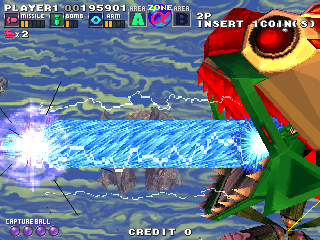
G-Darius © 1997 Taito Corp.
G-Darius literally added a new dimension to the highly regarded 'Darius' series, with the introduction of fully 3D rendered backgrounds and enemies. Namco had already done the same with their Xevious series for "Xevious 3D/G", released the year earlier, but G-Darius is generally regarded as the most accomplished of the two titles.
G-Darius' game-play was also enhanced, with the 'Capture Ball' system; this allowed the player to capture almost any enemy craft and use it against the game's other enemies. Captured enemies can either be detonated like a ''bomb'', damaging all enemies nearby; or used to fire a special 'Alpha Beam', which cuts through everything but gold-colored objects and enemy bosses. Each boss is capable of firing its own version of this beam at the player; when both beams meet, they will interrupt each other's path. Depending on how rapidly the player presses the Fire button, one beam will grow and eventually overpower the others. The Capture ball was actually introduced in "Darius Gaiden" but was only used to a minimal extent.
Taito FX-1B hardware
Prom Stickers : E39
Main CPU : PSX (@ 16.9344 Mhz)
Sound Chips : SPU (@ 16.9344 Mhz)
Players : 2
Control : 8-way joystick
Buttons : 6
G-Darius was released in July 1997.
The game got an update a couple of months later, known as "G-Darius ver.2".
The game forbids the initials 'SEX' on the high score table. If you try, it gets changed to 'AAA'.
Zuntata Records first released the soundtrack album for this game (Catalog No. ZTTL-0014) on August 21, 1997.
* Zone Select :
1. Hold Service Switch button during boot count.
2. Wait until machine displays 'Service Switch Error' on screen.
3. Push buttons in the following sequence 'Start(x3), Service Switch, Start'.
4. Insert credit then go to Zone Select screen.
1. Darius (1987, Arcade)
2. Darius II (1989, Arcade)
3. Darius Twin [Model SHVC-DT] (1991, Super Famicom)
4. Darius Force [Model SHVC-DH] (1993, Super Famicom)
5. Darius Gaiden - Silver Hawk (1994, Arcade)
6. G-Darius (1997, Arcade)
7. G-Darius ver.2 (1997, Arcade)
8. Darius Burst (2009, Sony PSP)
9. Darius Burst - Another Chronicle (2010, Arcade)
10. Darius Burst - Another Chronicle EX (2011, Arcade)
Producer : Naomitsu Abe
Director : Naomitsu Abe, Makoto Ohsaka, Akira Ohtsuki, Makoto Fujita
Character graphics : Makoto Fujita, Tohru Kawaishi, Kenichi Morita, Hiroshi Hasegawa, Toshihiro Fukui, Ryosuke Hayase, Atsushi Horimizu, Yatta Ushiroda, Baw Baw
Program : Akira Ohtsuki, Nobuyuki Hayashi, Katsuyuki Fujita, Takafumi Fujimoto, Hirohisa Matsumura, Hiroyuki Maruyama, Hikaru Taniguchi, Yasutaka Hayashi, Shunsuke Ono, Masakazu Takeda, Harumi.K, Hirotaka Fukakawa, Koji Kato, Hitoshi Kozuka
Music : Hisayoshi Ogura (Zuntata)
Sound effects : Yukiharu Urita (Zuntata)
Hardware : Katsumi Kaneoka
Design works : Naoto Hashizume
Quality warranty : Nobuhiro Koyama, Eiji Kawabata, Makoto Obonai
CONSOLES:
Sony PlayStation (mar.31, 1998) "G.Darius [Model SLUS-00690]"
Sony PlayStation (apr.9, 1998) "G-Darius [Model SLPS-01348]"
Sony PlayStation (1998) "G.Darius [Model SLES-01314]"
Sony PS2 (aug.25, 2005) "Taito Memories Gekan [Model SLPM-66092]"
Sony PlayStation 2 (mar.30, 2006) "Taito Legends 2 [Model SLES-53852]"
Sony PS2 (mar.31, 2006) "Taito Legends 2 [Model SLES-53852]"
Sony PS2 (may.16, 2007) "Taito Legends 2 [Model SLUS-21349]"
COMPUTERS:
PC [MS Windows, CD-ROM] by CyberFront.
Game's ROM.